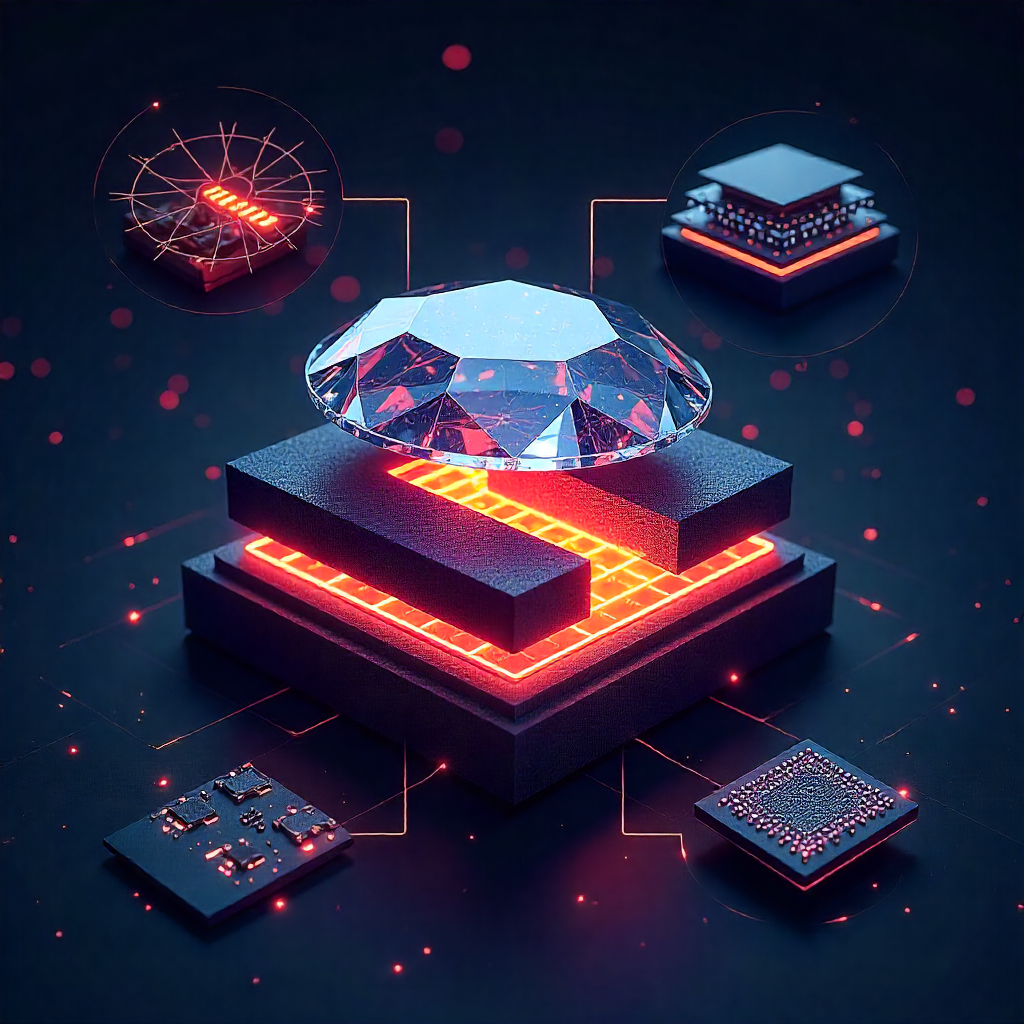
Heat: The Ultimate Constraint
In semiconductors, the limiting factor is no longer transistor count—it’s heat. Every design engineer working with GaN, SiC, or quantum devices is running into the same wall: how to move heat faster, more reliably, and at scale.
From one perspective, the argument is clear: we are building systems with power densities unthinkable a decade ago, and thermal management is the bottleneck. Solving it is not incremental—it determines whether AI servers, EV inverters, or radar arrays can continue scaling.
From another perspective, there is a reminder: solutions do not live in performance charts alone. A material must prove itself in manufacturability, cost, and supply chain. Diamond has unmatched properties, but adoption must be deliberate and paced.
Diamond’s Value: Why It Matters Now
Diamond brings a once-in-a-generation leap in thermal management:
- Thermal conductivity near 2000 W/m·K (far beyond copper, SiC, or AlN).
- Low coefficient of thermal expansion, reducing stress at interfaces.
- Wide bandgap (5.5 eV), making it robust in extreme environments.
For design engineers, this translates to:
- Lower junction temperatures.
- More reliable devices at higher power densities.
- Smaller, lighter cooling systems.
The visionary viewpoint sees diamond as a platform enabler, opening doors where today’s materials hit a wall. The pragmatic viewpoint emphasizes that it is not universal; diamond adoption should target the toughest bottlenecks, not replace every mature solution.
Diamond in High-Power Semiconductors
Power electronics for EVs, renewable energy, 5G, and defense all face the same stress: higher efficiency demands generate higher heat.
Where diamond fits best:
- GaN-on-Diamond HEMTs: Lower thermal resistance, enabling higher-frequency, higher-power RF devices.
- EV inverters: Diamond inserts extend SiC module lifetimes while reducing cooling system size.
- Aerospace/defense radars: Thermal margins determine mission reliability; diamond spreads heat where failure is not an option.
Thermal headroom translates directly into system-level gains: lighter EVs, denser base stations, and smaller radars. However, the cost curve must bend before adoption becomes mainstream.
Diamond in Quantum Systems
Quantum devices live at the opposite extreme: extreme sensitivity to even the smallest heat fluctuations.
- As a host: NV centers in diamond act as stable qubits, already advancing sensing and communication.
- As a stabilizer: Diamond spreads heat at cryogenic temperatures, maintaining uniformity for superconducting qubits and quantum photonics.
Thus, diamond is a direct enabler of stability and scale in quantum computing and sensing. The outlook is promising but still early-stage, with a long path to volume manufacturability.
Challenges Ahead
Every material with promise must survive contact with the realities of engineering and economics.
- High-quality synthetic diamond (CVD) remains expensive.
- Processing and metallization are more complex than with SiC or AlN.
- Large-area wafers are limited, constraining scale.
The story of silicon shows that ecosystems win—suppliers, standards, yields, reliability. Diamond must mature across all these dimensions.
Yet urgency remains: demand in AI, EVs, and quantum is so high that once diamond’s supply chain matures, adoption could be rapid and decisive.
Roadmap and Research Momentum
Evidence of progress is everywhere:
- GaN-on-Diamond prototypes cutting thermal resistance nearly in half.
- Diamond heat spreaders extending EV inverter lifetimes.
- Nanostructured films tuned for both thermal and mechanical performance.
- Quantum photonics leveraging diamond for stable single-photon emission.
The technology is still in its early phase—validated in select use cases but not yet mainstream. Once scalable manufacturing is achieved, adoption will likely surge rapidly rather than trickle in cautiously.
Guidance for Engineers Today
- Prototype where thermal bottlenecks dominate — radar, RF, EV inverters.
- Run simulations to test cost offsets from reduced cooling needs.
- Collaborate with suppliers of CVD diamond and bonded substrates.
- Design with flexibility — prepare for diamond integration as availability improves.
Closing: The Diamond Future
The future of semiconductors will be shaped as much by thermal design as by transistor scaling.
One school of thought sees diamond as inevitable for industries where performance gains are thermally constrained. Another sees it as conditional, requiring patient ecosystem building.
Both are correct. Diamond is not a universal replacement, but it is a necessary enabler for the next leap in AI, EV, and quantum technologies.
When we look back, diamond may not be remembered as exotic at all, but as the silent foundation that allowed the semiconductor roadmap to keep moving forward.



Leave a Reply